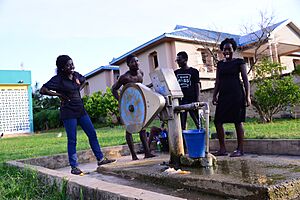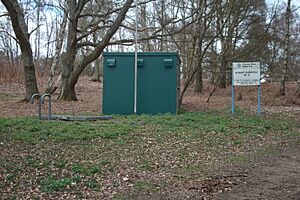Borehole facts for kids
A borehole is a narrow hole dug or drilled into the ground. It can go straight down (vertically) or sideways (horizontally). People make boreholes for many reasons. They might be looking for water (like a drilled water well), petroleum (oil), or natural gas.
Boreholes are also used to study the ground. This helps engineers understand the soil and rocks. They can also be used to measure the Earth's temperature. Sometimes, boreholes are made to install pipes or for special heating and cooling systems.
Contents
Why Boreholes Are Important
Engineers and environmental experts use boreholes to learn about the ground. They drill these holes to collect samples of soil, water, or rock. These samples are then tested in a lab. Scientists check their properties or look for any chemicals or pollution.
When a borehole is made for a water well, a special pipe called a casing is put inside. This pipe stops the hole from collapsing. It also helps keep dirt and pollution out of the water. This protects the water and any pump used to bring it up. Oil and natural gas wells are made in a similar way, but they are usually more complex.
Boreholes can also help us learn about Earth's past climate. By measuring temperatures at different depths, scientists can figure out how surface temperatures have changed over time.
Sometimes, groups of small boreholes are used to store heat or cold. This is like a giant underground battery for energy. It's called seasonal thermal energy storage. This system can store heat from summer to use in winter, or cold from winter to use in summer.
History of Boreholes
People have been drilling boreholes for a very long time. In ancient China, during the Han dynasty (around 202 BC to 220 AD), people were already drilling deep holes. They used them for mining and other projects. Some of these early boreholes could be as deep as 600 meters (about 2,000 feet)!
The Chinese used a clever method for drilling. A team of people would jump on and off a large beam. This made the drilling tool hit the ground with force. Buffalo and oxen would then turn the tool to help it dig deeper. This method was even used in California in the 1860s to get oil. By the first century BC, Chinese workers could drill boreholes up to 1,500 meters (about 4,900 feet) deep. By the 11th century AD, they could reach depths of 3,000 feet (about 914 meters). Drilling these holes took a very long time, sometimes almost ten years for just one well! Europe and the West did not catch up to this ancient Chinese technology until the 19th century.
For many years, the Kola Superdeep Borehole in Russia was the longest borehole in the world. It was drilled very deep into the Earth. Later, other wells, like the Sakhalin-I Odoptu OP-11 Well and the Chayvo Z-44 well, became the longest. These wells are very long but are drilled more horizontally than the Kola Borehole. In 2023, China started drilling new deep boreholes. One in the Sichuan Basin is planned to go 10,520 meters (about 34,510 feet) deep. Another in the Tarim Basin is planned for 11,100 meters (about 36,420 feet) deep.
How Boreholes Are Made
Drillers use special machines called drilling rigs to sink a borehole. Some rigs are very large, while others can be operated by hand. The type of machinery and the way they drill depend on many things. These include the type of ground, the purpose of the borehole, and the company making it. For drilling in the ocean, special floating platforms or platforms supported by the seafloor are used.
Hand Digging Boreholes
In many developing countries, boreholes are still dug by hand. This process starts with people using simple tools like shovels, picks, and crowbars. Workers dig the soil layer by layer. They often dig in a circular motion to make a good, round hole. This work is slow and needs a lot of effort and teamwork.
To stop the walls of the borehole from falling in, and to keep the water clean, the hole is lined. Materials like bricks, stones, or concrete rings are used for this. This lining makes the borehole strong and helps prevent dirt or pollution from getting into the water. A concrete base might be put at the bottom to stop sand from entering. The top of the borehole is then covered to protect it from trash and contamination.
See also
- Askam Borehole in Pennsylvania
- Casing cutter
- Deep borehole disposal
- Hole opener
- Horizontal drillhole disposal
- Kola Superdeep Borehole
- Vertical seismic profile




